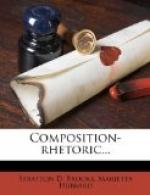The large branch of the Po we crossed came down from the mountains which we were approaching. As we reached the post road again they were glowing in the last rays of the sun, and the evening vapors that settled over the plain concealed the distant Alps, although the snowy top of the Jungfrau and her companions the Wetterhorn and Schreckhorn rose above it like the hills of another world. A castle or church of brilliant white marble glittered on the summit of one of the mountains near us, and, as the sun went down without a cloud, the distant summits changed in hue to a glowing purple, mounting almost to crimson, which afterwards darkened into a deep violet. The western half of the sky was of a pale orange and the eastern a dark red, which blended together in the blue of the zenith, that deepened as twilight came on.
—Taylor: Views Afoot.
+Theme LXV.+—Write a description in which the color element enters largely.
5. Animals, birds, fishes, etc.
The Tailless Tyke had now grown into an immense dog, heavy of muscle and huge of bone. A great bull head; undershot jaw, square and lengthy and terrible; vicious yellow gleaming eyes; cropped ears; and an expression incomparably savage. His coat was a tawny lionlike yellow, short, harsh, dense; and his back running up from shoulder to loins ended abruptly in a knoblike tail. He looked like the devil of a dog’s hell, and his reputation was as bad as his looks. He never attacked unprovoked; but a challenge was never ignored and he was greedy of insults.
—Alfred Ollivant: Bob, Son of Battle.
(Copyright, Doubleday and McClure.)
Read the description of the kingbird (page 224), and of the mongoose (page 242).
+Theme LXVI.+—Write a description of some animal, bird, or fish.
(What questions should you ask yourself about each description you write?)
6. Trees and plants.
How shall kinnikinnick be told to them who know it not? To a New Englander it might be said that a whortleberry bush changed its mind one day and decided to be a vine, with leaves as glossy as laurel, bells pink-striped and sweet like the arbutus, and berries in clusters and of scarlet instead of black. The Indians call it kinnikinnick, and smoke it in their pipes. White men call it bearberry, I believe; and there is a Latin name for it, no doubt, in the books. But kinnikinnick is the best,—dainty, sturdy, indefatigable kinnikinnick, green and glossy all the year round, lovely at Christmas and lovely among flowers at midsummer, as content and thrifty on bare, rocky hillsides as in grassy nooks, growing in long, trailing wreaths, five feet long, or in tangled mats, five feet across, as the rock or the valley may need, and living bravely many weeks without water, to make a house beautiful. I doubt if there be in the world a vine I should hold so precious, indoors and out.




